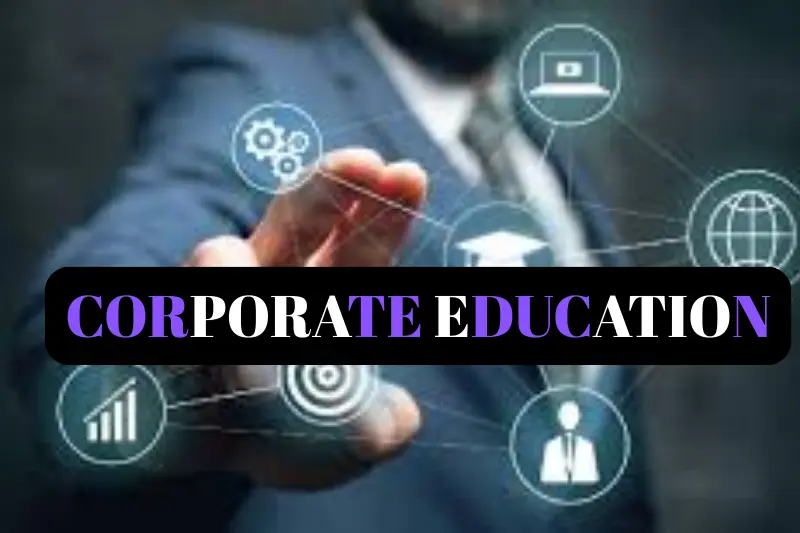Introduction
Corporate Education is becoming a powerful tool in today’s professional world. As companies grow and industries change, the need for continuous learning has increased. Many businesses now focus on employee development through structured learning programs. Corporate Education plays an essential role in this process, helping employees gain new knowledge, improve performance, and stay competitive in their fields.
In the modern business environment, companies are investing in employee training and development. This training goes beyond basic orientation and includes everything from leadership training to technical skill improvement. The goal is to build a smarter, more efficient workforce that contributes to the success of the organization.
Educational News often highlights how large companies use Corporate Education to address skill shortages and promote internal growth. These programs also align with strategic goals, helping companies retain talent and reduce turnover. Books and resources are available for companies to design effective Corporate Education programs. These include online platforms, instructor-led courses, and hands-on workshops.
Corporate Education

It refers to the training and development programs that companies offer to their employees. These programs are designed to help employees acquire new skills, improve existing abilities, and increase overall job performance. Corporate Education is a continuous process and can be delivered in various formats, including in-person training, online courses, workshops, and seminars.
- It is usually organized by a company’s human resources department or learning and development team. The main objective is to support business growth by equipping employees with the knowledge and skills needed for their roles. Corporate Education can cover technical subjects like coding or data analysis, as well as soft skills like leadership, teamwork, and communication.
- This type of education can be mandatory for certain roles or offered as an optional benefit. Some companies also partner with universities or educational platforms to offer recognized certifications or diplomas to employees.
- It is an investment. When companies invest in their workforce, they see better productivity, higher employee satisfaction, and reduced turnover. In a fast-changing business world, Corporate Education helps organizations stay ahead by ensuring their teams are always learning and improving.
Why Is Corporate Education Important ?
It is important because it helps both organizations and employees adapt, improve, and succeed in a competitive environment. Here are the key reasons why Corporate Education holds great value:
Improves Employee Performance
- It equips employees with the tools and knowledge they need to do their jobs better. Trained employees are more efficient and confident in their work.
Increases Job Satisfaction
- When employees are given opportunities to grow, they feel valued. Corporate Education creates a positive work environment that boosts morale and motivation.
Reduces Employee Turnover
- Employees are more likely to stay with a company that invests in their professional development. Corporate Education strengthens employee loyalty.
Boosts Company Reputation
- Companies known for good training programs attract top talent. Corporate Education enhances a company’s image in the market.
Promotes Innovation
- Learning new skills encourages creativity. Employees exposed to new ideas and technologies through Corporate Education are more likely to bring fresh solutions.
Supports Career Growth
- Employees can use Corporate Education to gain qualifications and move up the career ladder. This creates internal promotion opportunities.
Ensures Compliance
- In industries with strict regulations, Corporate Education ensures employees understand and follow rules, avoiding legal risks.
Improves Teamwork and Communication
- Training in soft skills improves collaboration among teams. Corporate Education helps build better communication in the workplace.
Supports Organizational Change
- When a company changes its processes or structure, Corporate Education helps staff adapt smoothly.
Enhances Customer Satisfaction
- Well-trained employees offer better service. Corporate Education contributes to a better customer experience, which leads to business growth.
Advantages Of Education And Disadvantages
Advantages
| Facilitates Career Advancement Education leads to promotions and salary increases. Employees who grow through Corporate Education often move up in their careers. |
| Improves Technology Use Employees trained on new tools and platforms are more comfortable using technology. This supports digital transformation. |
| Helps With Crisis Management Trained employees are better prepared to handle workplace challenges or emergencies. |
| Strengthens Company Culture It brings employees together for a common learning goal. It helps create a strong and unified work culture. |
| Reduces Recruitment Costs By training existing staff, companies fill roles internally rather than hiring from outside. This saves time and money. |
| Improves Organizational Efficiency Training reduces errors and improves quality. This helps the entire company function more smoothly and efficiently. |
| Develops Leadership Skills It helps identify and train future leaders within the company. It ensures a strong leadership pipeline. |
| Boosts Employee Engagement When employees receive training, they feel more connected to their organization. This leads to higher engagement and better work output. |
| Encourages Lifelong Learning It promotes continuous improvement. It allows employees to keep learning throughout their careers, which keeps skills sharp and knowledge updated. |
Disadvantages
| Resistance To Change Some employees may be resistant to new learning, especially if they are used to traditional ways of working. |
| Inconsistent Quality If not well-designed, some training programs may not deliver the expected results. |
| Technology Barriers Not all employees are comfortable with digital platforms, which can limit online training success. |
| Outdated Material Courses need to be regularly updated to stay relevant. Using old materials can hurt effectiveness. |
| Lack Of Follow-Up Without reinforcement or evaluation, employees may forget what they learned. |
| Limited Immediate Results It is a long-term investment. The benefits may not be visible right away. |
| One-Size-Fits-All Approach If the training is not personalized, it may not meet the unique needs of all learners. |
| Uneven Participation Not all employees may be equally motivated to participate, which can reduce the effectiveness of the program. |
| Time Consuming Employees may need to take time away from their regular tasks for training sessions, which may affect short-term productivity. |
| High Cost Training programs can be expensive, especially if done at a large scale or with external providers. |
A Step By Step Guide

Identify Training Needs
- Start by analyzing which skills your employees need based on business goals.
Set Clear Objectives
- Define what you want to achieve through Corporate Education, like improving productivity or preparing employees for new roles.
Choose The Right Format
- Decide whether training will be delivered online, in person, or in a blended format.
Select Learning Materials
- Use books and resources, software tools, and expert instructors to build your program.
Create A Learning Schedule
- Plan when and how often training will take place to ensure smooth integration with work responsibilities.
Involve Employees
- Ask for feedback and encourage participation to keep learners engaged.
Track Progress
- Use quizzes, assessments, and assignments to measure learning outcomes.
Provide Support
- Make sure employees have access to help if they face issues during training.
Evaluate The Program
- Review the effectiveness of your Corporate Education program regularly and make improvements.
Celebrate Success
- Acknowledge employees who complete training. This builds motivation and encourages others to participate.
Challenges And Their Solutions
Lack Of Time
Employees often find it hard to balance training with daily work tasks.
Solution: Offer flexible training schedules and short modules that fit into busy workdays.
High Cost
Developing and delivering training programs can be expensive.
Solution: Use online Corporate Education platforms and open-source tools to reduce costs.
Low Participation
Some employees may not show interest in training.
Solution: Create engaging, interactive sessions and link learning to rewards or promotions.
Outdated Content
Training programs can become irrelevant if not updated regularly.
Solution: Review and update content regularly based on current trends and feedback.
Limited Access To Resources
Employees in remote areas may lack access to training facilities or tools.
Solution: Use mobile-friendly and cloud-based platforms for Corporate Education.
Lack Of Management Support
Training may fail without leadership encouragement.
Solution: Involve leaders in planning and promoting Corporate Education initiatives.
One-Size-Fits-All Approach
Generic content may not meet individual learning needs.
Solution: Customize Corporate Education based on employee roles and skill levels.
Poor Tracking And Evaluation
Without proper tracking, it’s hard to measure training success.
Solution: Use learning management systems (LMS) to monitor progress and gather feedback.
Resistance To Change
Employees may be hesitant to adopt new learning methods.
Solution: Communicate the benefits of Corporate Education clearly and involve employees in the process.
Technology Issues
Technical problems can disrupt online learning.
Solution: Provide basic digital training and ensure a stable tech infrastructure.
Future Of Corporate Education
- The future of Corporate Education is dynamic and promising. With rapid changes in industries and technology, businesses are expected to invest more in upskilling their workforce. Online learning platforms will become more advanced, offering AI-driven personalized learning experiences. Hybrid models combining in-person and online training will become common.
- Companies will focus on continuous learning instead of one-time training sessions. Microlearning, where content is delivered in short and focused chunks, will grow in popularity. Virtual reality and simulations may also become part of Corporate Education to make learning more engaging and practical.
- Itwill align more closely with business strategies. Employees will have clear learning paths linked to their roles and career goals. Companies will track learning impact using data and adjust programs for better results.
- The future also includes stronger partnerships between companies and educational institutions. These collaborations will bring in certified programs and academic support, making Corporate Education even more effective and credible.
Frequently Asked Questions (FAQs)
What is Corporate Education?
Corporate Education is the training and development provided by companies to improve employee skills and performance.
Why is Corporate Education important?
It helps employees grow, improves productivity, and supports company goals.
Who needs Corporate Education?
All employees, from new hires to senior managers, benefit from Corporate Education to stay competitive and skilled.
Is Corporate Education costly?
It can have costs, but many companies use affordable digital tools to reduce expenses.
Can Corporate Education improve job satisfaction?
Yes, it helps employees feel valued, increases engagement, and supports career growth.
How is Corporate Education delivered?
It can be delivered through in-person sessions, online courses, workshops, and blended learning formats.
Is Corporate Education only for large companies?
No, businesses of all sizes use Corporate Education to improve employee performance.
What topics are covered in Corporate Education?
Topics include leadership, communication, technical skills, compliance, and customer service.
How is success in Corporate Education measured?
It is measured using assessments, performance reviews, and tracking learning progress.
Conclusion
Corporate Education is a powerful tool that supports both employee development and business success. It helps create a skilled workforce, increases job satisfaction, and keeps companies competitive in the fast-changing business world. With proper planning and the right tools, Corporate Education can bring lasting value to any organization.
Ten Bonus Tips For Effective Corporate Education
Start With A Needs Assessment
Understand what skills are needed before designing the program.
Set Clear Learning Goals
Define what success looks like for each training session.
Use Engaging Formats
Incorporate videos, interactive quizzes, and case studies.
Make It Role-Specific
Customize training for different departments and job roles.
Encourage Peer Learning
Create opportunities for employees to learn from one another.
Track Progress
Monitor learning through tests, reports, and feedback.
Provide Ongoing Support
Offer help through mentors or help desks during training.
Update Content Regularly
Keep learning materials current and industry-relevant.
Celebrate Achievements
Recognize and reward employees who complete training successfully.







